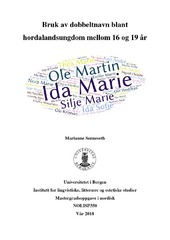| dc.description.abstract | Mastergradsoppgavens hovedproblemstilling er: «Bruker hordalandsungdommer på 16-19 år dobbeltnavnet sitt?». Målet med oppgaven er å vise både i hvor stor grad ungdommer med doble fornavn, bosatt i Hordaland, bruker og blir tiltalt med hele dobbeltnavnet sitt, og om det er noen faktorer som påvirker denne bruken. Slike faktorer kan være oppkalling, bindestrek, samklang, kjønn og bosted. Primærmaterialet til masteroppgaven er svar på to ulike spørreundersøkelser: en stor som baserer seg på svar til 322 ungdommer i Hordaland med dobbeltnavn, og en liten som baserer seg på svar til 11 mødre til ungdommer i Hordaland med dobbeltnavn. Spørsmålene i spørreundersøkelsen har vært en blanding av avkrysning på svaralternativer og noen få åpne svar. Det er en blanding av kvantitativ og kvalitativ metode, med hovedvekt på kvantitativ. Det fagteoretiske bygger på tidligere forskning om dobbeltnavn, oppkalling og motivasjon, samt begrepsavklaringer rundt dobbeltnavn. Dette bygger på stoff fra flere land, men med hovedvekt på norsk. Det gjelder også flere tidligere hovedfagsoppgaver som bl.a. undersøker bruk av dobbeltnavn, oppkallingstradisjon og motivasjon rundt navngiving til barn. Etter innledning og problemstilling kommer en del om faghistorie og teori for dobbeltnavn, oppkalling og motivasjon, med flere hypoteser underveis. Metodedelen beskriver en todelt undersøkelse, en for ungdommer og en for mødre. For ungdommene blir det gjort greie for hvordan undersøkelsen blir gjennomført med verktøyet SurveyXact, og søknadsprosessen til Personvernombudet. For mødrene blir det gjort greie for framgangsmåte for gjennomføring av spørreundersøkelse med anonym papirpost. I neste del blir resultatet lagt fram, og her blir også hypotesene testet og det drøftes rundt dem. Oppgaven avslutter med en drøfting hvor det blant annet blir svart på både hovedproblemstilling og underproblemstillinger. Resultatet av masteroppgaven viser at gjennomsnittlig 27,5 % av ungdommene med dobbeltnavn i Hordaland presenterer seg med hele dobbeltnavnet sitt, 20 % blir tiltalt med hele dobbeltnavnet sitt og 65 % skriver hele dobbeltnavnet sitt i uformelle sammenhenger. I tillegg viser resultatet at det er flere faktorer som påvirker bruken av dobbeltnavn, som f.eks. bindestrek og om man bor på bygd eller i by. | en_US |
| dc.description.abstract | The research question of the master’s thesis is «Do the youths in Hordaland, aged 16-19, use their double names? ». The purpose of the thesis is to show both the extent to which youngsters with given double names, living in Hordaland, use and are addressed with their entire double name and whether there are any factors that affect this usage. Such factors may be naming after family members, hyphens, harmony, sex and place of residence. The primary material used in the thesis are the results of to two different surveys, by usage of questionnaires; one major survey based on the response from 322 youths with double names and, additionally, a small one based on the response of eleven mothers of young people in Hordaland with double names. The questions, that make up the survey, are a combination of ticketing on response options and answering open questions. The method used is a mixture of quantitative and qualitative, with emphasis on the quantitative aspect. The theoretical substance of the text is constructed based on previous research on given double names, naming after family members, and motivation, as well as conceptual explanations with regards to double names. The subject material originates in several countries, but the main emphasis is on the Norwegian material. This also applies to several previous research theses, which examines the use of double names, the tradition of naming after family members and the motivation for naming children. Following the introduction and the research question, there is a section containing subject history, as well as, theories concerning double names, naming after family members and motivation for this, including several hypotheses. The section outlining the method for the thesis describes a two-part survey, one for the research group of young people with double names, and one for mothers of these. For the first group, the conduction of the survey has been outlined using the SurveyXact tool, and the application process to Data protection official for research (Personvernombudet for forskning) is included. The mothers have been informed using a procedure for conducting survey with anonymous paper post. In the next part, the result is presented, the hypotheses are tested and also discussed. The end of the dissertation mainly consists of a discussion, which addresses both the main thesis and additional research questions. The result of the master’s thesis shows that an average of 27,5 % of young people given double names aged 16-19 originating in Hordaland presents themselves with their entire double name, while 20 % are addressed using their entire double name and 65 % write their entire double name in informal contexts. In addition, the result shows there are several factors that affect the use of double names, such as hyphens and whether you live in a rural area or in a city. | en_US |
